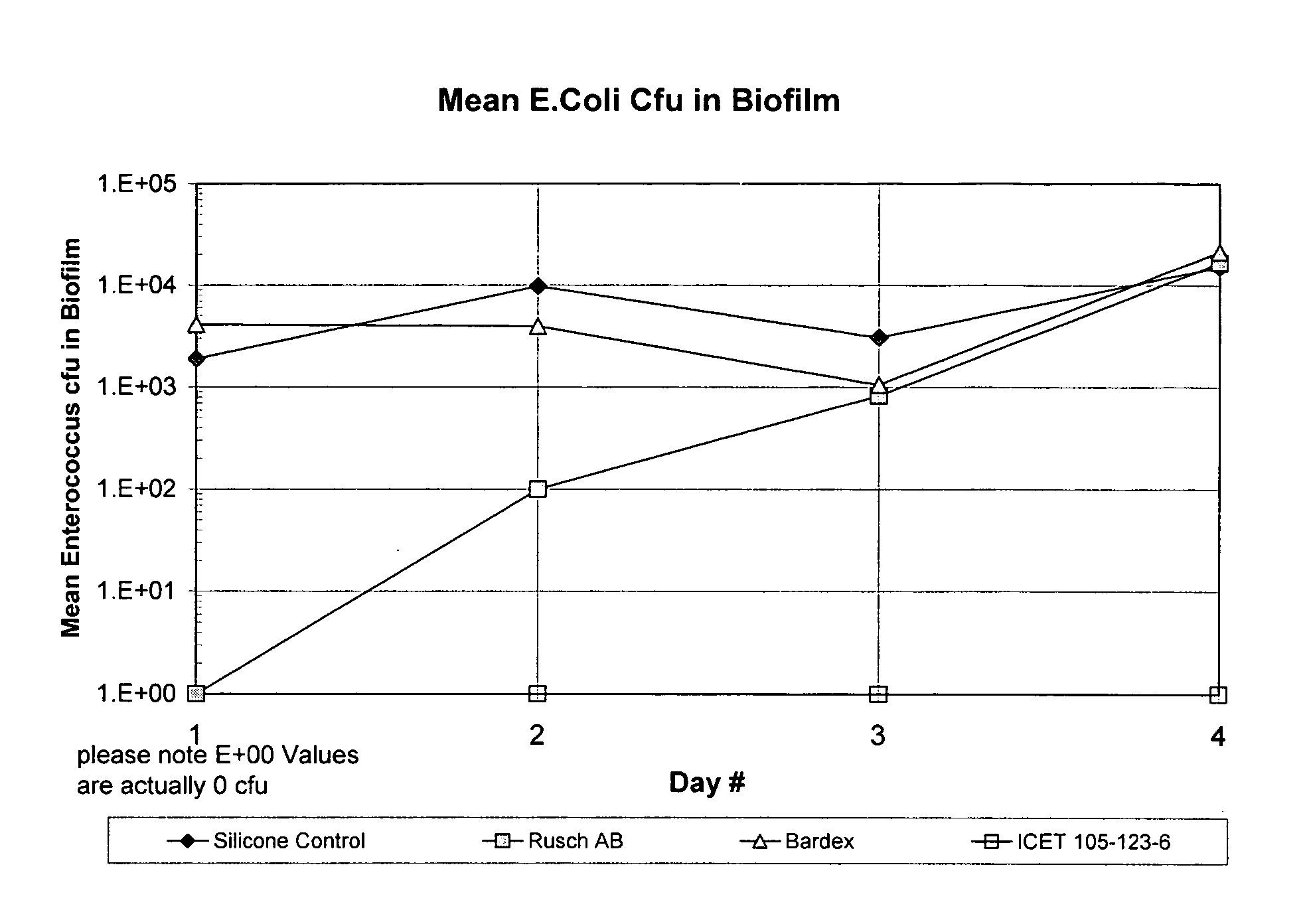Antimicrobial composition for medical articles
- Summary
- Abstract
- Description
- Claims
- Application Information
AI Technical Summary
Benefits of technology
Problems solved by technology
Method used
Image
Examples
example 1
This is Example of Coating Silicone on Silicone Material
[0048] The following chemicals were blended:
[0049] (1) 3.0 g (16.12 wt %) silver citrate (Sigma-Aldrich Chemical, USA)
[0050] (2) 1.5 g (8.0 wt %) silver-copper alloy nanopowder (Nanopowder Ind,, Israel)
[0051] (3) 3.0 g (16.12 wt %) citric acid (Sigma-Aldrich)
[0052] (4) 8.9 g (43.0 wt %) butyl paraben (Spectrum Chemicals, USA)
[0053] (5) 3.0 g (16.12 wt %) ethylene diamine tertaacetic acid, diacid form (Sigma-Aldrich)
[0054] (6) 0.1 g (0.05 wt %) copper phthalocyanine (Spectrum Chemical) Ten grams of this blend was added to another 0.25 gm of copper phthalocyanine and 150 mL of dry n-hexane. To that mixture was added 75 gm of “RTV 118” (McMaster Co, NJ, USA). To this was slowly added 5 gms dry pulverized polyethylene oxide (MW 4,000,000). Using a homogenizer, the contents were mixed well and transferred to a dipping tank, forming a solution containing about 1 to 15 wt % of the antimicrobial composition.
[0055] The silicone ...
example 2
[0056] Composition A
[0057] The following formulation was prepared without titanium dioxide:
[0058] 16.1 wt % silver citrate
[0059] 8.0 wt % silver-copper
[0060] 16.0 wt % citric acid
[0061] 43 wt % butyl paraben
[0062] 16 wt % EDTA, diacid form
[0063] 1 to 3 wt % copper phthalocyanine
[0064] The ingredients were weighed and ground to a fine powder in an industrial blender. Prior to coating, 5 wt % polyethylene oxide (based on the weight of the RTV silicone resin to be added), was added to the powder and ground well. The composition was kept dry, in closed containers or in a low temperature oven.
[0065] Composition B
[0066] A second formulation was prepared with titanium dioxide.
[0067] 10.5 wt % silver citrate
[0068] 5.3 wt % silver-copper
[0069] 21.0 wt % citric acid
[0070] 42 wt % butyl paraben
[0071] 10.5 wt % EDTA, diacid form
[0072] 4.2% copper phthalocyanine
[0073] 6.3 wt % titanium dioxide
[0074] Prior to coating, 5 wt % polyethylene oxide (based on the RTV silicone resin we...
example 3
[0075] Using a 200 mesh screen, 4 gms of the powder compositions 2A and 2B were sieved and dried in an oven at about 50° C. for 30 minutes. Polyethylene oxide powder was also sieved using a 325 mesh screen and dried at about 50° C. for 30 minutes to an hour. The polyethylene oxide and the powder composition were mixed together under dry conditions. Then 6 gm of “GE 118” RTV silicone resin was diluted with 60 gm of hexane that had been dried using molecular sieves. The mixture of the polyethylene oxide and the powder composition were slowly mixed and the new mixture was sonicated at level 3 for 8 minutes. Then 26 gm of “GE 118” RTV silicone resin was stirred in at room temperature.
[0076] Articles were dipped into the solution 1 to 3 times, each time drying the coating for at least 15 minutes at room temperature. The coatings were air-dried under ambient humid conditions overnight followed by further drying at 60° C. for 1 to 2 hrs.
[0077] In this example, duplicate samples(referred ...
PUM
| Property | Measurement | Unit |
|---|---|---|
| Time | aaaaa | aaaaa |
| Time | aaaaa | aaaaa |
| Time | aaaaa | aaaaa |
Abstract
Description
Claims
Application Information
 Login to View More
Login to View More - R&D
- Intellectual Property
- Life Sciences
- Materials
- Tech Scout
- Unparalleled Data Quality
- Higher Quality Content
- 60% Fewer Hallucinations
Browse by: Latest US Patents, China's latest patents, Technical Efficacy Thesaurus, Application Domain, Technology Topic, Popular Technical Reports.
© 2025 PatSnap. All rights reserved.Legal|Privacy policy|Modern Slavery Act Transparency Statement|Sitemap|About US| Contact US: help@patsnap.com

